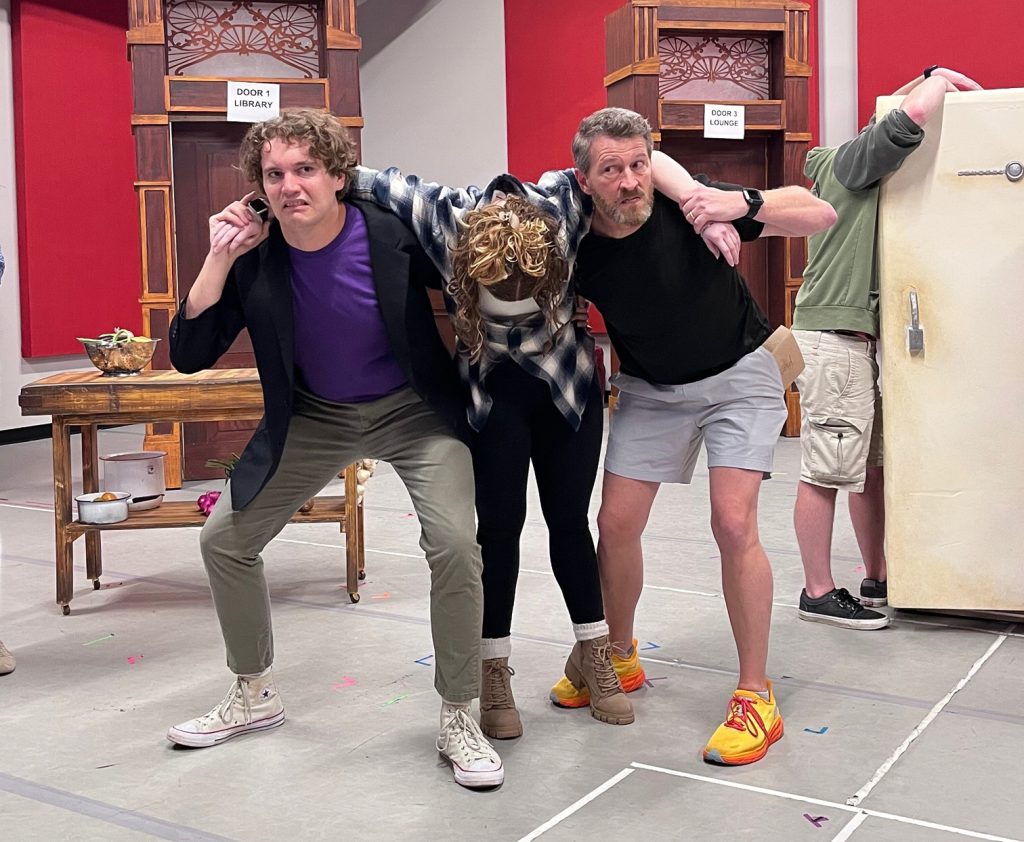We spoke with Caleb S. Garner, our Lighting Designer, bringing his skills to the Dock Street Theatre once again in our production of CLUE: ON STAGE. Get your tickets to the show here, and read on to learn about his artistic process in designing the lighting for this hilarious whodunit!
1) CLUE: ON STAGE is known for its mix of mystery, comedy, and suspense. What drew you to this particular play, and what aspects of the script did you find most exciting or challenging from a lighting design perspective?
I did not know the movie until I was in undergrad, so I didn’t really approach the production with the same nostalgia factor that several of the other production members had. When I saw it for the first time, I was especially drawn to the larger-than-life characters in literal life or death situations. They take themselves so incredibly seriously, and yet most of the things they say and do are absolutely not serious and irreverent. It’s like your group of friends sitting around the dining room table playing the game together and having fun. We poke at each other, we over-act our characters, we take ourselves too seriously, and then we laugh! I think that’s my favorite challenge of this play – How can we make it a serious, noir-style, murder mystery that’s also fun and wacky with lots of physical comedy? It’s been a great balancing act.
2) The play features a variety of scenes set in different rooms of the mansion, each with its own mood and atmosphere. How are you using lighting to create distinct settings and enhance the storytelling within these spaces?
The entire team has been working hard to shape the world of the play for several months now. When we first met as a production team, all of the designers brought in images that we felt reflected the tone of the script. We discussed all of our images, and picked from them to create a unified collage that represented the visual identity of the production. Below is a look at what we decided as a team.
I really responded to the colors of the actual Clue game pieces and the use of strong colors and highlights to create drama and emphasis. Each room has its own furniture pieces and shaping that gives it a unique character. I tried to add to it by bringing in the highlights and colors you see in the collage – a beam of light here, a window there, and some fun with the angle and direction of light. One of the things I’m especially proud of is the work that scenic designer Adam Jehle and I did in trying to separate the distinct locations within the mansion. We have a series of mobile doors with transom windows that I lit internally so the light level and color coming from the window can be individually changed as they are moved throughout the space. We also have a fun series of portraits on the upstage wall that do something special that I can’t give away – you’ll have to see for yourself!
3) CLUE: ON STAGE often involves quick changes in lighting to accentuate comedic moments, surprise reveals, or suspenseful scenes. How did you choreograph and execute these lighting cues to maximize their dramatic impact?
Lighting, like comedy, is all about the timing. A well-timed light cue could be a joke in itself – and in several places it is! There are several places in which the lighting design works together with sound to help accentuate comedy onstage. In the opening sequence of the show several of the characters recognize each other upon seeing each other in the mansion. The actors have this exaggerated gesture of shock or disdain, but we really emphasize it with a change of light and a sound. The combinations of acting, light, and sound help turn a small moment into a big joke.
In addition to the images in our collage, I was also really inspired by some Edward Hopper paintings. They were really intense and sharp. Just like the characters onstage, they took themselves very seriously. I really liked the idea of these funny moments happening within a stark Hopper painting, so I tried to incorporate some of his elements into the show. It’s a life-or-death situation, it’s melodramatic, and it’s very, very funny.

Edward Hopper, Conference at Night
4) Mystery plays often require careful use of lighting to build suspense and enhance the mystery-solving aspect of the story. How did you approach creating and controlling the suspenseful lighting effects in the production?
Costumes and scenery help to physically shape the world of the play, but lighting and sound shape the way the audience perceives the play. As a team, we were also very interested in the way that light helped to shape the bodies and scenery in a “film noir” style with strong highlights and deep shadows. It was a cool way to contrast the sharp edges and lines of the original Clue game board, the Victorian style of the scenic design, and the softer, curvier contours of the costume design. It helps to frame each suspenseful moment in a way that is visually interesting and ghostly. I found that the more I lean into the odd angles and colors, the more intense the moments in the scene became.

Steven Assael, Bride With Cards
The opening sequence of the production starts with Yvette the maid in front of a TV listening to a broadcast of Senator McCarthy. She is lit primarily from the TV, with some light from above and the sides filling in. I tried to capture the spirit of the image above, Bride With Cards, in using a primary source of light from an interesting angle to turn Yvette watching TV into a strong, mysterious image to set the tone of the show from the beginning. A few lightning flashes help, too!
5) What is your approach to designing and programming lighting effects for specific moments or scenes that require precise timing and coordination with other elements of the production?
When reading the script, there are several things that are written for you from the beginning. Things like blackouts, lightning flashes, and scene changes are already written into the script, but my job is to look beyond what is written and see what else we need to tell the story. I like to think of this in three separate ways. The first thing I do is think about how I can support the other design elements in building the world of the play. What are the literal things I need to reinforce? How can I light the scenery in a way that helps to shape the room? How can I reinforce the scenic and costume designer’s color choices? How do I reveal the forms onstage, and how do I hide the things that don’t need to be seen? How do I work with sound to reinforce mood and tone?
From world-building, I like to shift to the rhythm of the text. I hear the script of the play like music: there are always themes, mood changes, repetitions, dynamics, and rhythms. I like to listen to the way the actors say the lines to try and get a sense of their timing. The way they play to the text can determine the speed of the lighting cues, moments to highlight, and help to establish the tone of the lighting.
The third thing I think of is where the actors will physically be onstage. Part of my job is putting light where we need it and taking away from the places we don’t’ need it. When we’re in tech rehearsals for the show, I like to call it “big paintbrush lighting,” and “small paintbrush lighting.” Sometimes the scenes with large numbers of actors or scenes where most of the playing space is used require me to use my ‘big paintbrush’ and light large sections of the stage. Think back to the big dance numbers in The Prom or in Once on This Island, where I use big, broad “brush strokes” to make sure the whole space is attractively lit. Clue needs my “small paintbrush.” We’ve got tight, specific scenes where we only want to highlight a single actor and hide lots of secrets onstage. Every show requires both paintbrushes, but it takes a good eye and some great collaborators to know which to use.
6) Were there any technical challenges or special effects in CLUE: ON STAGE that you anticipated, and how did you plan to address them through your lighting design?
One of the major technical challenges for Clue is that it is playing alongside The Lightning Thief. It is hard to give each show its own unique identity with the technical limitations of the space. Lightning Thief has several pieces of flying scenery that need to be revealed throughout the show, but that means that the lights for those pieces of scenery are no longer available to use in Clue. I’ve had to really think critically about the needs for each show and how we transition from one show to the other. There’s always a big battle between what I want artistically and what I can physically do with the limitations of time, equipment, and other shows.
Another challenge in this show was lighting the transom windows in six movable doors. I had to find a way to light, power, charge, and control the transom windows as they are moved across the stage in an elaborate Scooby-Doo-esque chase sequence. I had to custom build several components of the door windows, so I’m really excited about how they turn out! You can see the unlit doors in the recent rehearsal photos.

7) Finally, what excites you the most about our audiences experiencing CLUE: ON STAGE and witnessing your lighting design?
This show is very different from the last few shows that I’ve done, so I’m very happy to put on such a snappy show that really allows me to play with some great colors, unconventional angles, and a lot of wonderful collaboration with some of my favorite people. I’m excited for the audience members to experience a lighting style that’s a little different than what we usually offer that is presented in such a funny way. I hope that everyone has as much fun watching the show as I have designing it!
Get your tickets to see CLUE: ON STAGE, running October 18th – November 5th, at CharlestonStage.com.

Caleb S. Garner is a lighting and sound designer based in Charleston, SC. A North Carolina native, Caleb received his B.A. and B.F.A. from Catawba College in Salisbury NC, and his M.F.A. from the University of Southern Mississippi. Garner’s designs, ranging from concerts to ballets to musicals to plays have earned him eight regional and national design awards. Caleb has been a featured designer from New York to Mississippi, designing in the Northeast, Midwest, East Coast and Deep South. Caleb enjoys turning large pieces of wood into smaller pieces of wood (sometimes mistakenly called furniture), screaming with students (often recognized as teaching), and playing with things that spark and smoke. Caleb currently serves as the Resident Lighting Designer at the Charleston Stage Company and serves as an adjunct lecturer at the College of Charleston.
